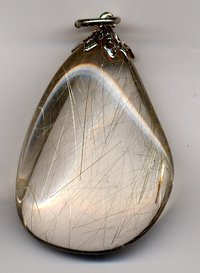Rutile
|
|
Rutile.jpg
- rutile, a tetragonal mineral usually of prismatic habit, often twinned;
- anatase or octahedrite, a tetragonal mineral of octahedral habit; and
- brookite, an orthorhombic mineral. Both octahedrite and brookite are relatively rare minerals.
Rutile has a sub-conchoidal fracture, is brittle, has a metallic-adamantine lustre, and is generally reddish brown but also sometimes yellowish, bluish, or violet. Rutile derives its name from the Latin rutilus, red, in reference to the deep red color observed in some specimens when viewed by transmitted light. Natural rutile is usually opaque or very dark red. It is transparent to opaque. Rutile may contain up to 10% iron. Rutile is the most stable form of titanium dioxide and is produced at the highest temperatures, with brookite being formed at lower temperatures and octahedrite being formed at still lower temperatures.
Rutile is found as an accessory mineral in some altered igneous rocks, and in certain gneisses and schists. In groups of acicular crystals it is frequently seen penetrating quartz as in the "fléches d'amour" from Grisons, Switzerland. Small rutile needles present in gems are responsible for "star" sapphires, "star" rubies and other "star" gems, an optical phenomenon known as asterism.
Rutile has among the highest refractive indices of any known mineral, and also exhibits high dispersion. These properties have led to several industrial applications, including the production of white paint pigments. Synthetic rutile was first produced in 1948 and is sold under a variety of names. Synthetic rutile can be made in a variety of colors, but not a pure transparent white, being always slightly yellow. A consequence of the high refractive index is an adamantine lustre that leads to an appearance that makes it seldom used in jewellery. It is not very hard, only about 6 on the Mohs hardness scale. The near colorless diamond substitute is sold under the name Titania.
See also: List of mineralsde:Rutil fr:Rutile nl:Rutiel pt:Rutilo sv:Rutil

